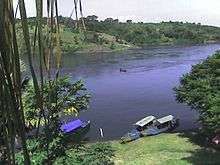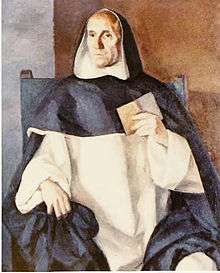Jeremy Lawrance
Jeremy Norcliffe Haslehurst Lawrance FBA (born 12 December 1952) is a British linguist and historian. Professor at Manchester and later at Nottingham, and Fellow of the British Academy since 2011,[1] he was President of the Association of Hispanists of Great Britain and Ireland from 2004 to 2006.
Life

Born at Jinja, Uganda, near the source of the River Nile, Lawrance was the son of Jeremy Charles Dalton Lawrance, OBE and officer of the Colonial Administrative Service, by his marriage to Elizabeth Ann Haslehurst.[2] His father was also a writer on the Iteso people and their language[3] and on African land tenure.[4]
Lawrance was educated at King's School, Canterbury, and Balliol College, Oxford, where he graduated MA in 1978 and DPhil in 1983. From 1978 until 1985 he was a Fellow of Magdalen College, Oxford. In 1985 he migrated to the University of Manchester, where he was a lecturer in Spanish until 1993, then Professor of Spanish until 2006. From 2006 up until his retirement in 2018, he has been Professor of Spanish Golden Age Studies at the University of Nottingham. In 2018 Lawrance moved back to Oxford, where he holds an Honorary Research Fellowship at the Faculty of Medieval and Modern Languages.
His areas of academic interest are the impact of humanism and the revival of learning in Spain during the Renaissance and the Baroque era, the history of Spanish cultures in the Middle Ages and the early modern period, and editing unpublished manuscripts and early printed books.[5] His most notable work includes a critical translation of Francisco de Vitoria's political writings, with Anthony Pagden, published by Cambridge University Press in 1991.[6]
In Who's Who, Lawrance states his recreations as "Searching for stone circles with daughter, entertaining friends, evading capture by elephants, loud music, geriatric football, Bologna."[7]
Selected publications

- "On Fifteenth-Century Spanish Vernacular Humanism" in Ian Michael and Richard A. Cardwell (eds.), Medieval and Renaissance studies in honour of Robert Brian Tate (Oxford: Dolphin, 1986)[8]
- Francisco de Vitoria: political writings, ed. and translated with Anthony Pagden (Cambridge University Press, 1991)[7]
- "The Middle Indies: Damião de Góis on Preseter John and the Ethiopians" in Renaissance Studies 6 (1992)
- Alfonso de Palencia: Gesta Hispaniensia, ed. and translated with Brian Tate, vol. 1 (1998), vol. 2 (1999)[7]
- "Black Africans in Renaissance Spanish literature", Chapter 3 of Thomas Foster Earle, K. J. P. Lowe (eds.), Black Africans in Renaissance Europe (2005)
- "Illustrating the Language: the cultural role of translation in the Spanish Renaissance" in Rhian Davies, Anny Brooksbank Jones (eds.), The Place of Argument: essays in honour of Nicholas G. Round (2007), pp. 125–148
- The Textual History and Authorship of Celestina, with Alan Deyermond and Keith Whinnom (Department of Hispanic Studies, Queen Mary, University of London, 2007)
- Spanish Conquest, Protestant Prejudice: Las Casas and the Black Legend (Nottingham, 2009)[7]
Notes
- "Elections to the Fellowship: 2011: Professor Jeremy Lawrance". British Academy. Archived from the original on 8 May 2014. Retrieved 7 May 2014.
- Corona: The Journal of His Majesty's Colonial Service (Vol 5, H.M. Stationery Office, 1953), p. 76: "Lawrance. — On the 7th December, 1952, at Jinja, to Elizabeth Ann (nee Haslehurst), wife of Jeremy C. D. Lawrance, Colonial Administrative Service, Uganda — a son (Jeremy Norcliffe)"
- Jeremy Charles Dalton Lawrance, The Iteso: Fifty Years of Change in a Nilo-Hamitic Tribe of Uganda (London, 1957); J. H. Hilder, Jeremy Charles Dalton Lawrance, An Introduction to the Ateso Language (1957); J. H. Hilders, J. C. D. Lawrance, An English-Ateso and Ateso-English vocabulary (1958)
- J. C. D. Lawrance, Fragmentation of Agricultural Land in Uganda (1963); J. C. D. Lawrance, Report on Squatters on Farms in Swaziland (1964); J. C. D. Lawrance, Registration of Title in the Western State of Nigeria (1971); J. C. D. Lawrance, Land Tenure: Kenya (1978); J. C. D. Lawrance, Land Tenure, Swaziland (1978); J. C. D. Lawrance, Cadasters and Land Registration (1984)
- Jeremy Lawrance profile Archived 15 October 2013 at the Wayback Machine at nottingham.ac.uk, accessed 4 May 2014
- Edward Craig, ed., Routledge Encyclopedia of Philosophy: Index (1998), p. 645
- 'LAWRANCE, Prof. Jeremy Norcliffe Haslehurst', in Who's Who 2014 (London: A. & C. Black, 2014), online edition by Oxford University Press, December 2013, accessed 3 May 2014 (subscription site)
- Arthur Terry, Tirant Lo Blanc: New Approaches (1999), p. 134
External links
- Jeremy Lawrance profile at nottingham.ac.uk